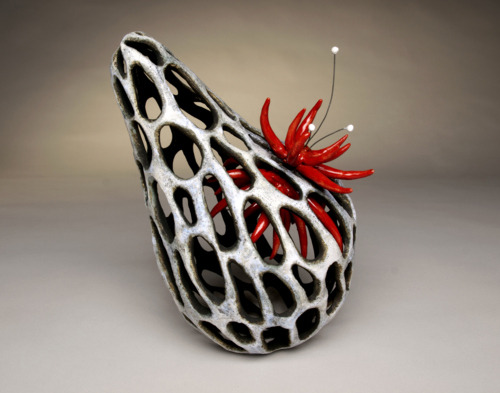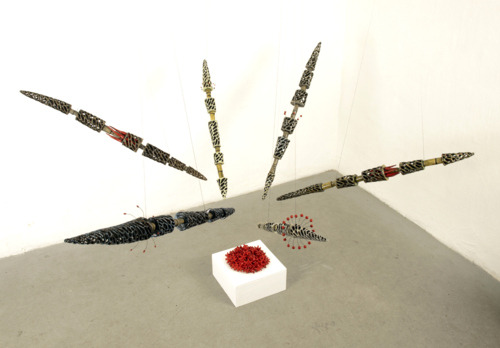
You are presenting yourself as a sculptor even though you have a BFA in Ceramics. What are you currently working on?
Although I’ve been educated in all aspects of ceramics; pottery, functional hand-building or sculpture, I’ve chosen to focus on abstract sculptural ceramics. I feel that if I say I’m a ceramicist, people either don’t know what I’m talking about or they assume I throw pots, so I feel that introducing myself as a sculptor who works with clay is a more precise description of the work I create. Right now, I’m working with organic forms that have holes cut into them, and those forms have other ceramics pieces that are trapped inside. This process of trapping forms has manifested itself into multiple series of work. I’m conceptually playing with the balance between trapping and protecting an object and simultaneously exploring abstract ways to express that in clay.
What triggered the passion for ceramics in you?
I have always worked with clay, my parents still have the first coil pot I made as a kid and I just never stopped working with clay. I was lucky enough to of had an in depth ceramics program in my high school. That exposure gave me the experience to explore clay and know that it was going to be my focus at the university level. I also really love the process of working with clay; each stage that you go through from a soft, malleable material to a fired finished piece offers the chance that everything can go wrong at any step in the process. Having the ability to balance control over the clay and letting what happens happen is always a battle for me that I’m very attracted to. I’m constantly learning new techniques or possibilities with clay whether it’s through taking a workshop or seeing another artist at work. Clay is a very basic, primitive material that can be used in such varied and technological ways; it’s a constant learning process.
You are creating your pieces with a real sense of originality, and you are also constructing geometrical shapes that are completing the spectrum of natural forms. How did the fascination for natural and organic shapes start?
My early work reflects ocean forms; corals, shells, anemones because I spent a lot of time around the ocean and underwater, then I moved into a redwood forest and my work referenced seeds, pollens, insects so now I think that I’m at a point in my work where those worlds have collided and I’m finding a balance between both the above and below sea level sources. Along this journey, I’ve also discovered the importance of balancing the organic with the geometric. All organic in clay seems too blobby to me, and all geometric seems to be fighting such a supple material, so I try play with the balance of both.

Branch Series V (installation), 2011, ceramic & high temperature, wire, variable dimensions
In 2005, you opened the Earth Art Studio in Aptos, CA, and more recently HOPE Art – a humanitarian group that brings art to the youth of Haiti. Tell us more about these projects.
Earth Art Studio is my home studio that I share with my students. I teach ceramics and mixed media sculpture classes to kids, teens and adults there. The studio has been open for almost 7 years, but I have been a teacher forever it seems, it comes naturally to me and I get inspired by what my students create and by their comments on seeing my work in progress. I also love the challenge of answering all of their questions. www.earthartstudioaptos.com
I’m proud to be a founding member of HOPE Art which brings art to kids in disaster stricken areas as a form of stress relief and self-esteem; we’ve been working in Port Au Prince, Haiti for over 1 year. I’ve personally been on 3 out of the four trips our group has made this past year, and it has been life changing. Meeting working artists in Haiti has been an amazing and unexpected experience in itself. But my favorite moments are when I teach the kids how to draw something simple like an animal or everyday object and then the next day they run up to me and show me all the drawings that they’ve done overnight, perfecting the steps and so proud that they can draw that one thing. It’s really incredible to see the pride in their faces; it transcends language and cultures. HOPE Art is based on the idea that “Art is the Universal Language”. www.projecthopeart.org
You are working on many projects at the moment, and you are also creating a new series of works. Where can we find you in the near future?
I was recently selected to participate in the Ceramics Annual of America exhibition in San Francisco at the Fort Mason Center in September. I’m looking forward to this event and meeting the other participating artists. I’m planning to show a new series of work at this event. I also show my work at local venues year-round in the Santa Cruz, CA area and participate in the annual Open Studios Art Tour. And I welcome studio visits anytime!
By Alexandra Mureşan and Vasi Hîrdo
Published in Ceramics Now Magazine Issue 2
View Jenni Ward’s profile on Ceramics Now.
Visit Jenni Ward’s website.




















